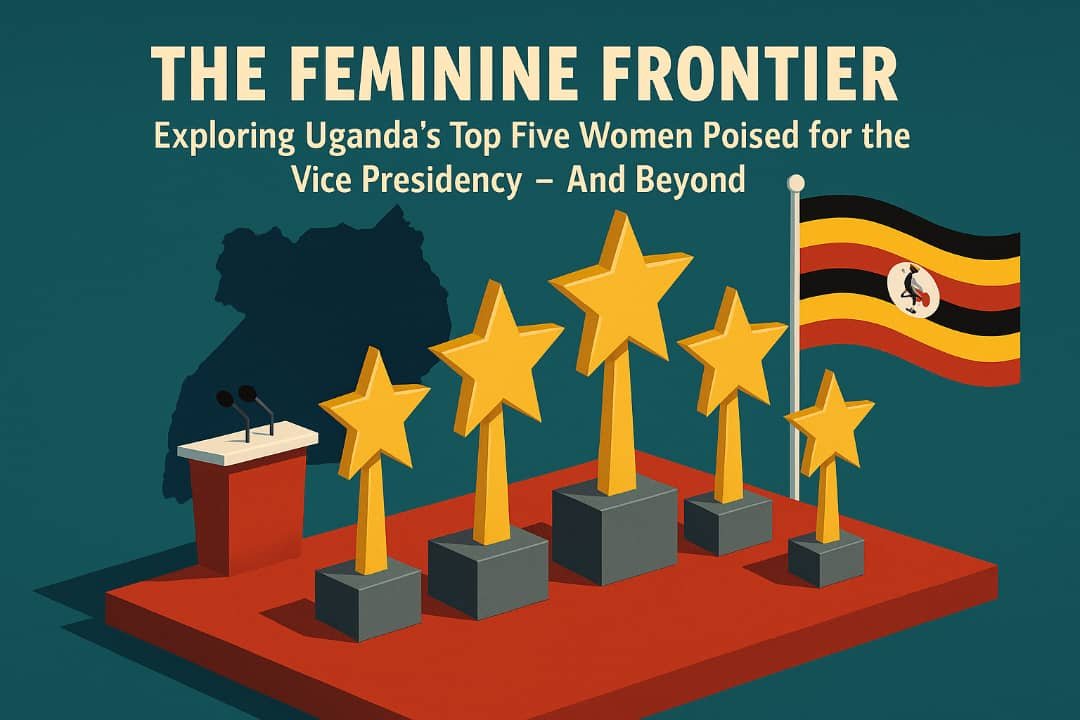By Isaac Christopher Lubogo, a Ugandan lawyer and lecturer
“When a nation reaches for its future, it must look to the wombs that birthed it—not just biologically, but ideologically.”
— Isaac Christopher Lubogo
DISCLAIMER
This analysis is strictly intellectual, non-partisan, and guided by the principles of academic freedom, constitutional discourse, and political ethics. The views herein do not reflect any endorsement or political instruction. Rather, this discourse is meant to stimulate national reflection, inform civic dialogue, and provoke thought in the spirit of constructive engagement.
Every evaluation is grounded in verifiable public data, media reportage, historical actions, and the observable temperament and trajectories of the figures analyzed. This is not speculation—it is analytical projection.
> The Constitution of the Republic of Uganda (1995) guarantees the right to expression (Art. 29), the principle of equal opportunity (Art. 21), and the recognition of gender equity in governance (Art. 33). This discourse operates within that sacred legal framework.
The Moment We Must Not Miss
In a nation where women make up over 51% of the population, where youth cry for fresh leadership, and where the old order clings tightly to expired mandates, Uganda is faced with a decisive opportunity:
To redefine the meaning of power by entrusting it to competent women who have walked through fire, diplomacy, blood, ridicule, and resilience.
Gone are the days when the Vice Presidency was treated as a ceremonial chair awaiting retirement. Today, it must be seen as a strategic transition node, a national heartbeat, and a silent rehearsal for the top job. And for the first time in Uganda’s history, the field of serious contenders is rich with powerful, competent, seasoned—and yes—female possibilities.
The Top Five Titans of Tomorrow
This analysis presents the five most potent women whose political narratives, credentials, and symbolism place them in strong contention for Uganda’s next Vice Presidency or presidency:
1. Jessica Alupo – the quiet stabilizer currently holding the Vice Presidency.
2. Rebecca Kadaga – the constitutional matriarch and speaker emeritus.
3. Anita Among – the iron-fisted Speaker and new power broker.
4. Robinah Nabbanja – the populist Prime Minister with a pulse on the street.
5. Winnie Byanyima – the globally respected diplomat, technocrat, and reformer-in-waiting.
Each of these women embodies a different Uganda:
One reflects continuity.
Another carries institutional justice.
One represents political grit.
Another commands grassroots loyalty.
And one offers global legitimacy and visionary policy leadership.
But only time—and national discernment—will reveal which of these women will not only be chosen but prove worthy of the moment.
Why This Discourse Now?
Because Uganda cannot afford another accidental Vice President.
Because women are no longer tokens of inclusion—they are strategic assets of transformation.
Because tomorrow’s Uganda must not be birthed from yesterday’s fears.
And because sometimes, when the old world refuses to die, it is the daughters of the nation who must midwife its rebirth.
Below is a deeply analytical, intellectually grounded, and empirically referenced discourse on the top five most plausible female leadership contenders for Uganda’s Vice Presidency or Presidency, blending public opinion data, historical credibility, personality analysis, and socio-political relevance. These five are:
1. Jessica Alupo
2. Rebecca Kadaga
3. Anita Among
4. Robinah Nabbanja
5. Winnie Byanyima
Uganda’s Female Leadership Horizon: A Grounded Analysis of the Top Five Contenders for National and Diasporic Transformation
“Leadership is not about occupying space, but about changing it.” — Lubogo Philosophy
I. Contextual Backdrop: Why This Conversation Matters Now
Uganda stands at the edge of a generational and ideological cliff. With President Yoweri Museveni now entering his fifth decade of political influence, the search for new national faces—especially female ones—has intensified. The current socio-political terrain is marked by:
An overwhelmingly young population (over 78% under 30).
A disillusioned diaspora yearning for reformist leadership.
Institutional fatigue, where Parliament, the Judiciary, and the Presidency are increasingly seen as closed circuits of aging elites.
A post-COVID, debt-heavy economy requiring economic technocrats and global negotiators, not just political survivors.
In this context, we must analyze the five leading women not merely for their popularity, but for their philosophical fitness, reform potential, and capacity to symbolically and practically carry Uganda into its next chapter.
1. Jessica Alupo: The Quiet Stabilizer
Alupo, the current Vice President and former Education Minister, holds military discipline, academic credentials, and a calculated political modesty.
The Good:
She represents the moderate center, a safe space in a polarized polity.
Maintains strong rapport with the President and military elites—a vital currency in Uganda’s realpolitik.
Regionally inclusive (from Teso), helping balance the ethnic matrix of power.
The Bad:
Lacks public ideological voice—she neither inspires fear nor hope.
Her presence is often overshadowed; absence of public engagement during crises (e.g., lockdown brutality, economic struggles) weakens her legacy.
The Ugly:
Could easily become a puppet to dominant forces, rather than a driver of reform.
If Uganda faces a transition crisis, her non-confrontational nature could lead to passivity at a critical moment.
“Alupo is governance’s ghost—present but almost invisible.”
2. Rebecca Kadaga: The Constitutional Matriarch
The former Speaker of Parliament and current 1st Deputy Prime Minister, Kadaga is the longest-serving woman in Uganda’s power structure.
The Good:
Deep knowledge of Uganda’s constitutional machinery.
Seen as a protector of cultural and institutional sovereignty—defended Buganda, gender rights, and national identity in Parliament.
Represents firm femininity without compromise.
The Bad:
Her confrontations with President Museveni have cost her trust within the ruling establishment.
Perceived as part of the old order, despite her reformist tone.
The Ugly:
Her return to cabinet was seen as political appeasement—a betrayal of her defiant legacy.
May be used to symbolically “mother” a nation she’s no longer empowered to lead.
“Kadaga walks like a lioness but was caged by the very lions she once fought.”
3. Anita Among: The Calculated Iron Lady
Anita Among is Speaker of Parliament and has emerged as a bold, unapologetic power figure, defying senior leaders and fiercely defending her turf.
The Good:
Speaks the language of the street and the elite—connecting easily with rural supporters while mastering parliamentary rules.
Has shown resilience and audacity, essential traits in post-Museveni Uganda.
Strong managerial instincts, with Parliament visibly more active under her.
The Bad:
Seen as too aligned with the First Family, raising credibility concerns among opposition supporters and the diaspora.
Sometimes excessively combative, risking institutional instability.
The Ugly:
Accusations of corruption, patronage, and intolerance could derail a presidency.
May be repeating Museveni’s hyper-centralized model, only younger and smarter.
> “Among is not building a new Uganda—she’s building a younger version of the old one.”
4. Robinah Nabbanja: The People’s Nurse or Populist Pawn?
Currently Prime Minister, Nabbanja is Uganda’s first female in that role, with a background in community health and district politics.
The Good:
Appeals to grassroots as a woman of the people.
Her COVID-19 food aid program, though controversial, gave her a national face.
Ranked highest in the New Vision female leadership poll (15.3%).
The Bad:
Lacks elite legitimacy; often mocked by technocrats and MPs alike.
Poor policy articulation, sometimes undermining her office’s seriousness.
The Ugly:
May become a symbolic female leader, used to mask deeper systemic patriarchy.
Her rise appears choreographed, raising questions about genuineness vs. convenience.
“She’s loved by the masses, but distrusted by the machinery.”
5. Winnie Byanyima: The Global Progressive
Currently Executive Director of UNAIDS and former Oxfam International chief, Byanyima has international gravitas and a technocratic mind.
The Good:
Global respect, with diplomatic experience that could stabilize Uganda’s foreign image.
Advocate for human rights, social justice, and healthcare reform.
Represents the intelligentsia of the diaspora—a figure who can rally global Ugandans.
The Bad:
Has been long absent from Uganda’s grassroots political terrain.
Perceived as too intellectual or radical for the NRM power base.
The Ugly:
Her association with Besigye, though noble, could polarize her appeal.
Might face severe resistance from conservative institutions if she attempts reform too quickly.
> “Byanyima is Uganda’s best chance for global legitimacy, and also its greatest risk of internal rejection.”
Synthesis: The Philosophical Question
The question is no longer “who is popular?” but:
Who among these five can lead Uganda into a new era without carrying the toxicity of the old?
Alupo is stable but uninspiring.
Kadaga is wise but wounded.
Among is sharp but ruthless.
Nabbanja is beloved but unrefined.
Byanyima is brilliant but politically estranged.
For the International Diaspora
Ugandans in the diaspora crave a leader who understands policy, democracy, and global negotiations—not just loyalty to the status quo.
Winnie Byanyima ranks highest here, followed by Kadaga for her integrity.
Among and Nabbanja, though locally influential, struggle with global credibility.
Alupo is viewed as too quiet to lead Uganda on the world stage.
Conclusion: Who Then?
If Uganda seeks elite consensus and continuity, Alupo will remain the vice of choice.
If it craves grassroots populism, Nabbanja or Among will rise.
If it desires global respect, policy reform, and diaspora reconnection, Byanyima is the strategic queen.
If the nation yearns for constitutional dignity and wise transition, Kadaga is unmatched.
Ultimately, Uganda must decide:
> Do we want female leadership as symbolism, or as transformation? Do we want to honor the past, survive the present, or build a radically different future?
That choice is not about gender. It is about vision.








